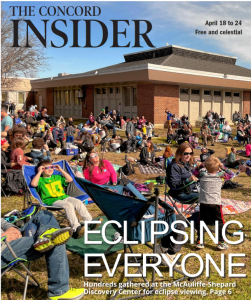June 29, 1873 – The North Church burns. It will be rebuilt on the same spot – North Main and Chapel streets – and open for worship less than three years later.
June 29, 1775 – Dr. Josiah Bartlett, a New Hampshire colonial leader, writes to his wife: “We are reduced to choosing between submission to tyranny of irritated ministers, or resistance by force. The latter is our choice.”
June 29, 1864 – The Legislature meets to hear Manchester's case that it should displace Concord as New Hampshire's capital. Speaking in Concord's defense, John George wins the day by arguing that in addition to lagging behind Concord in railroad development, Manchester has a population that is “not steady and sober. Passions, excitements and tumults are likely to be generated at any time.”
June 30, 1944 – More than three weeks after D-Day, dreaded telegrams reach Concord homes bringing news of casualties in the Allied invasion of Europe. They include a paratrooper and an Army lieutenant who are both missing and Lt. Guy Gowen, a 24-year-old infantry patrol leader who had reached Normandy by glider before being killed in action. Gowen had been a two-sport star at Concord High, graduating in 1937.
July 1, 1927 – At nightfall, 2,000 people gather at the State House plaza to watch Mayor Fred Marden push the button that will illuminate Concord's new “White Way” for the first time. Concord Electric Co. has installed 126 large bulbs to light the way, which runs more than mile along Main Street, from Kelly's drug store to Larkin's store. A Monitor reporter hears someone whisper in the crowd: “I hope they go on.” They do indeed, causing “a spontaneous uproar and the blowing of hundreds of automobile horns.”
July 2, 1941 – Joe DiMaggio hits a line drive home run over the head of Ted Williams in left field to break Wee Willie Keeler's record 44-game hitting streak. On base when he hits it is Yankee third baseman Red Rolfe of Penacook.
July 4, 1899 – Ten thousand people attend the dedication of the Memorial Arch in front of the State House. Cut from Concord granite, it is 33 feet 8 inches high and 53 feet wide. Though built on state land, it was paid for by the city and commemorates Concord's war veterans.
July 4, 1891 – A crowd of 6,000 to 7,000 people gathers at the circus grounds just above Bridge Street along the Merrimack River to watch a holiday baseball game. The Concord YMCA team, a perennial power, defeats the Concord Stars, 13-12. “Fielding at times was rather loose,” the Monitor reports.
July 4, 1858 – Congressman Mason W. Tappan reads the Declaration of Independence on the State House lawn. Solon Gould, an inflexible Concord Democrat, happens by as Tappan is reading the Declaration's litany of complaints against King George. Thinking that the object of Tappan's scorn is President James Buchanan, Gould proclaims the reading a “Black Republican affair” and storms off.
July 5, 1874 – Prominent Concord lawyer Anson Southard Marshall dies of a gunshot wound. The previous day, Marshall took his wife and young son for a Fourth of July picnic near Lake Penacook. The family heard target shooting by a militia company nearby. Marshall stood to call to the shooters and request that they be careful. He was immediately shot in the abdomen.









